The AMD A8-7650K APU Review, Also New Testing Methodology
by Ian Cutress on May 12, 2015 10:00 AM ESTGaming Benchmarks: High End
Alien: Isolation
If first person survival mixed with horror is your sort of thing, then Alien: Isolation, based off of the Alien franchise, should be an interesting title. Developed by The Creative Assembly and released in October 2014, Alien: Isolation has won numerous awards from Game Of The Year to several top 10s/25s and Best Horror titles, ratcheting up over a million sales by February 2015. Alien: Isolation uses a custom built engine which includes dynamic sound effects and should be fully multi-core enabled.
For low end graphics, we test at 720p with Ultra settings, whereas for mid and high range graphics we bump this up to 1080p, taking the average frame rate as our marker with a scripted version of the built-in benchmark.
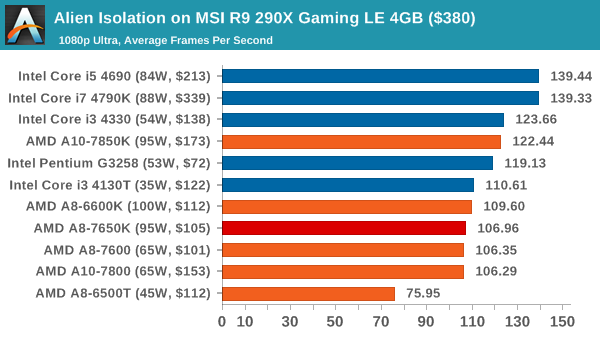
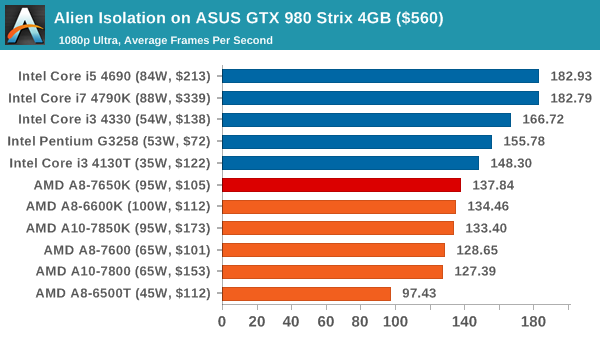
When using the R9 290X, the AMD APUs (except for the 7850K) are within a few percentage points for average frame rates compared to similarly priced Intel processors. You need to spend $200 to get a +30% increase in frame rates. That being said, the frame rates in all our results (except the A8-6500T) were all above 120 FPS on the GTX 980, albeit with the G3258 and i3-4130T ahead by ~10%.
Total War: Attila
The Total War franchise moves on to Attila, another The Creative Assembly development, and is a stand-alone strategy title set in 395AD where the main story line lets the gamer take control of the leader of the Huns in order to conquer parts of the world. Graphically the game can render hundreds/thousands of units on screen at once, all with their individual actions and can put some of the big cards to task.
For low end graphics, we test at 720p with performance settings, recording the average frame rate. With mid and high range graphics, we test at 1080p with the quality setting. In both circumstances, unlimited video memory is enabled and the in-game scripted benchmark is used.
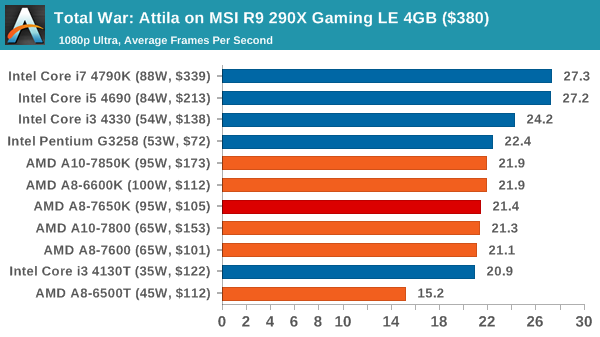
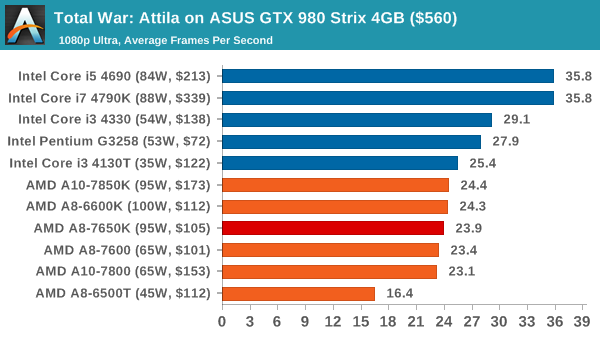
With both of our high end cards, the true quad cores from Intel give performance gains but the better performer here is the G3258 when considering price.
Grand Theft Auto V
The highly anticipated iteration of the Grand Theft Auto franchise finally hit the shelves on April 14th 2015, with both AMD and NVIDIA in tow to help optimize the title. GTA doesn’t provide graphical presets, but opens up the options to users and extends the boundaries by pushing even the hardest systems to the limit using Rockstar’s Advanced Game Engine. Whether the user is flying high in the mountains with long draw distances or dealing with assorted trash in the city, when cranked up to maximum it creates stunning visuals but hard work for both the CPU and the GPU.
For our test we have scripted a version of the in-game benchmark, relying only on the final part which combines a flight scene along with an in-city drive-by followed by a tanker explosion. For low end systems we test at 720p on the lowest settings, whereas mid and high end graphics play at 1080p with very high settings across the board. We record both the average frame rate and the percentage of frames under 60 FPS (16.6ms).
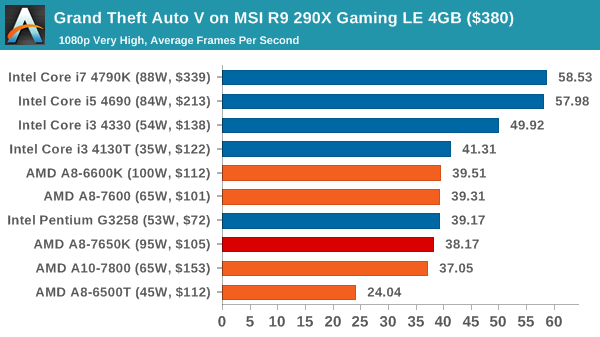
![Grand Theft Auto V on MSI R9 290X Gaming LE 4GB ($380) [Under 60 FPS]](https://images.anandtech.com/graphs/graph9217/74256.png)

![Grand Theft Auto V on ASUS GTX 980 Strix 4GB ($560) [Under 60 FPS]](https://images.anandtech.com/graphs/graph9217/74268.png)
The A8-7650K remains competitive in GTA around the $100 price point, but the i3-4130T for an extra $17 gets a slightly better score.
GRID: Autosport
No graphics tests are complete without some input from Codemasters and the EGO engine, which means for this round of testing we point towards GRID: Autosport, the next iteration in the GRID and racing genre. As with our previous racing testing, each update to the engine aims to add in effects, reflections, detail and realism, with Codemasters making ‘authenticity’ a main focal point for this version.
GRID’s benchmark mode is very flexible, and as a result we created a test race using a shortened version of the Red Bull Ring with twelve cars doing two laps. The car is focus starts last and is quite fast, but usually finishes second or third. For low end graphics we test at 1080p medium settings, whereas mid and high end graphics get the full 1080p maximum. Both the average and minimum frame rates are recorded.
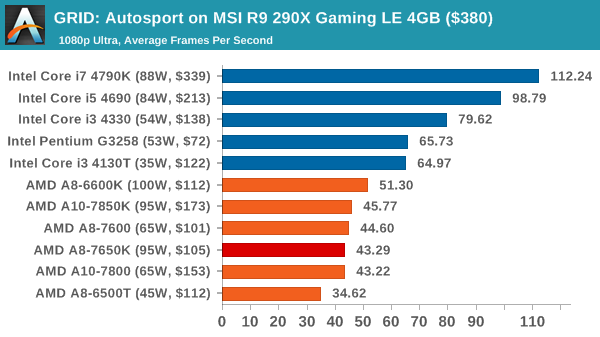
![GRID: Autosport on MSI R9 290X Gaming LE 4GB ($380) [Minimum FPS]](https://images.anandtech.com/graphs/graph9217/74258.png)
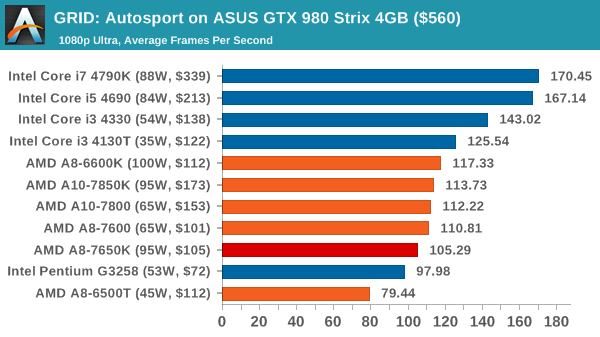
![GRID: Autosport on ASUS GTX 980 Strix 4GB ($560) [Minimum FPS]](https://images.anandtech.com/graphs/graph9217/74270.png)
GRID, as we saw on the other testing, still seems optimised for Intel CPUs. The minimum frame rates are the key metric here, especially on the R9 290X.
Middle-Earth: Shadows of Mordor
The final title in our testing is another battle of system performance with the open world action-adventure title, Shadows of Mordor. Produced by Monolith using the LithTech Jupiter EX engine and numerous detail add-ons, SoM goes for detail and complexity to a large extent, despite having to be cut down from the original plans. The main story itself was written by the same writer as Red Dead Redemption, and SiM received Zero Punctuation’s Game of The Year in 2014.
For testing purposes, SoM gives a dynamic screen resolution setting, allowing us to render at high resolutions that are then scaled down to the monitor. As a result, we get several tests using the in-game benchmark. For low end graphics we examine at 720p with low settings, whereas mid and high end graphics get 1080p Ultra. The top graphics test is also redone at 3840x2160, also with Ultra settings, and we also test two cards at 4K where possible.
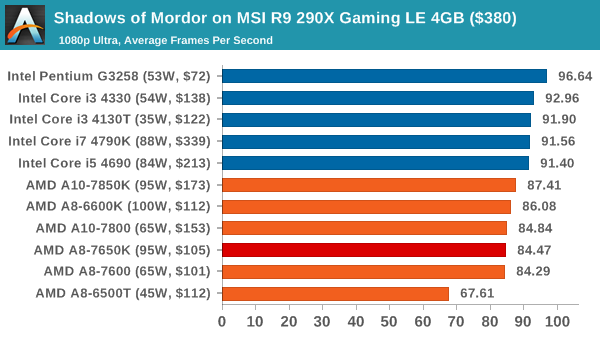
![Shadows of Mordor on MSI R9 290X Gaming LE 4GB ($380) [Minimum FPS]](https://images.anandtech.com/graphs/graph9217/74260.png)

![Shadows of Mordor on ASUS GTX 980 Strix 4GB ($560) [Minimum FPS]](https://images.anandtech.com/graphs/graph9217/74272.png)
SoM at 1080p shows small differences between AMD and Intel here, though you might be hard pressed to notice them.
Middle-Earth: Shadows of Mordor at 4K
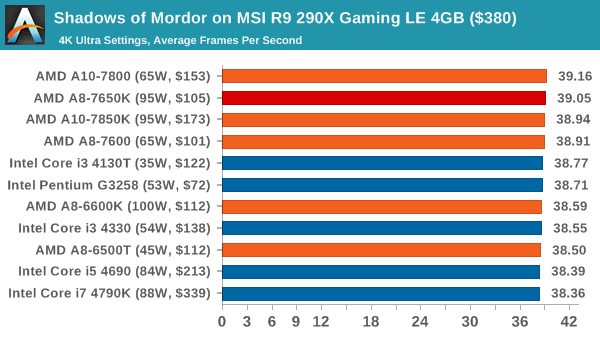
![Shadows of Mordor on MSI R9 290X Gaming LE 4GB ($380) [Minimum FPS]](https://images.anandtech.com/graphs/graph9217/74262.png)
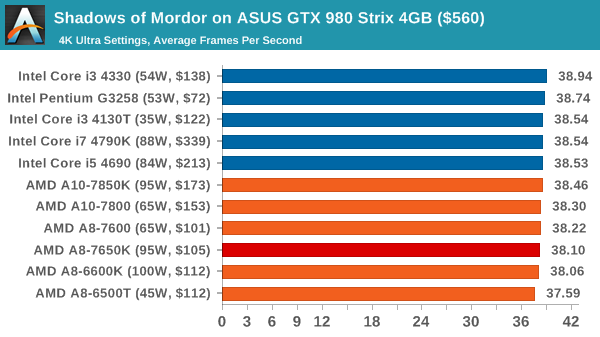
![Shadows of Mordor on ASUS GTX 980 Strix 4GB ($560) [Minimum FPS]](https://images.anandtech.com/graphs/graph9217/74274.png)
Moving to 4K evens out the average frame rates on all our CPUs, although a slight latter is appearing on the minimum frame rates.
Middle-Earth: Shadows of Mordor CrossFire at 4K
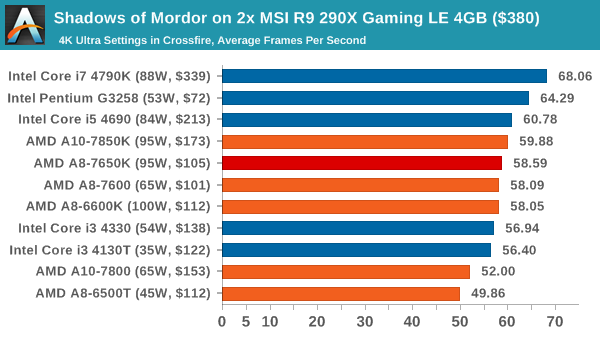
![Shadows of Mordor on 2x MSI R9 290X Gaming LE 4GB ($380) [Minimum FPS]](https://images.anandtech.com/graphs/graph9217/74264.png)
Bumping up to dual R9 290Xs shows that the A8-7650K is highly competitive in both average and minimum frame rates.















177 Comments
View All Comments
akamateau - Tuesday, May 12, 2015 - link
Your comments assume that ANAND provided benchmarks using DX12 and they did not. ALL of the GRAPHIC benchmarks were with either synthetic benchmarks or game benchmarks using DX11.DX11 cripples the performance of ALL APU's, IGP and dGPU. Draw calls ARE a measure of CPU-to-GPU "bottleneck" or elimination thereof. You can not render a polygon until you draw it.
DX12 enables CPU core scaling; basically increased draw calls are a function of the amount of multithreaded cpu cores. DX11 does not allow multithreeaded gaming.
DX11 may be current but why should I base hardware purchases from testing based on obsolete software AND benchmarks?
DX12 will be in widespread use by game developers by Christmas.
Anand has psent quite a bit of time and money testing hardware on obsolete benchmarks TO WHAT END?
Starswarm and 3dMArk API Overhead Test are available but ANAND ignore them.
Why?
AMD's APU was designed to FLY using Mantle and DX12. It is not AMD's fault that Intle IGP is so poorly designed. That is Intel's problem.
Test Intel IGP using the latest API and you will see. Comaparatively test AMD and Intel using obsolete benchmarks with DX11 and ANAND is lying to the consumer and can not be trusted.
AN unbiased and well balanced piece should use legacy benchmarks, they should also use the very latest available. ANAND di not do this.
rp1367 - Tuesday, May 12, 2015 - link
"Starswarm and 3dMArk API Overhead Test are available but ANAND ignore them.Why?"
Because they want to hide the truth. "It is hard for a person to wake if he is asleep because he pretends to be asleep but infact he is not. He just want to fool you because of his stupidity"
The refusal to support the upcoming DX12 give as hint that the review is biased and something fishy going at the backdoor. I am not an IT guy and new on this site but i could easily detect what is the difference between biased and unbiased review.
The reviewer and Anadtech guys for sure are all intellegent guys but they allowed themselves to be succumed by their own personal interest.
Gigaplex - Tuesday, May 12, 2015 - link
Or its just something as simple as DX12 not being released yet, the performance is likely to change, so is an invalid test for comparing hardware at this time. The benchmarks you refer to are only valid as a preview for potential gains.akamateau - Tuesday, May 12, 2015 - link
Windows 10 with DX12 will be released in less than 2 months. Mantle is final and DX12 is final. Anand has it but ignores it.By Christmas ALL new games released will be DX12.
Gigaplex - Tuesday, May 12, 2015 - link
DX12 may not be final. API probably is, runtime is likely close, drivers likely won't be.And you're delusional if you think all new games released at the end of this year will be DX12. It takes years to develop a AAA game, so they would need to have started before DX12 was available. The market for DX12 will be tiny by Christmas as DX12 will be Windows 10 only. Not everyone will be willing or able to upgrade the OS. Not all hardware even supports DX12. You're completely ignoring the history of previous DirectX roll outs.
akamateau - Tuesday, May 12, 2015 - link
Windows 10 with DX12 will be released in less than 2 months. Mantle is final and DX12 is final. Anand has it but ignores it.By Christmas ALL new games released will be DX12.
V900 - Tuesday, May 12, 2015 - link
Ah, so basically the choice is buy an AMD APU and get shoddy performance now, and great performance in a year, or buy an Intel/Intel-Nvidia solution and get great performance now and great performance in a year!So theres really no reason to get the AMD is what you're saying?
JumpingJack - Tuesday, May 12, 2015 - link
I will bet you what ever you make in a year that not all games released between DX12 release and christmas of this year will be DX12 native.akamateau - Tuesday, May 12, 2015 - link
@Ian Cutress"as well as having parallelizable code"
ARE YOU NUTS?
You really need to cut the crap.
Mutlthreaded gaming will come as a result of DX12 and Asynchronous Shader Pipelines and Asynchronous Compute Engines.
galta - Tuesday, May 12, 2015 - link
I don't think he is nuts, but you seem a bit angry.From a CPU perspective, multithreaded games need not wait for DX12. They could have been written before.
Anyway, we have a clear statement of you: DX12 will make AMD shine. We should talk again on Christmas.
Just keep in mind that the same was said when DX11 was about to be released, with known results...